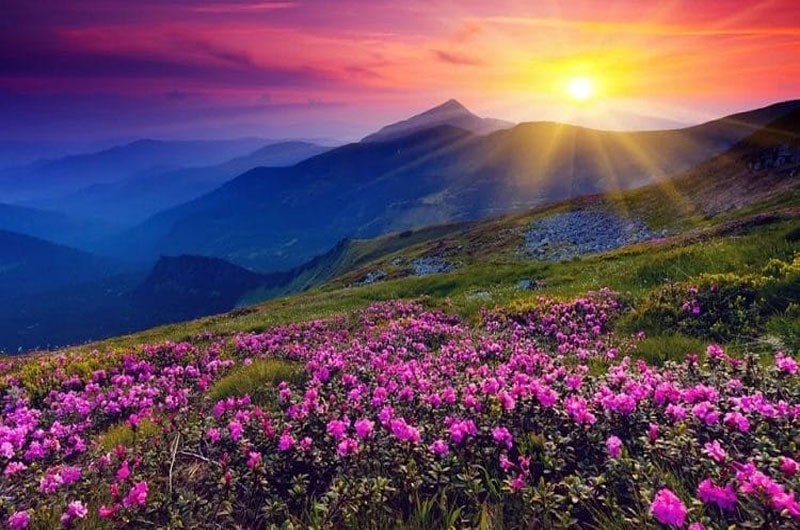
Valley of Flowers National Park: Nature’s Canvas in the Himalayas – A World Heritage Site
The Valley of Flowers National Park, nestled in the Western Himalayas of Uttarakhand, India, is a paradise of alpine meadows, vibrant flora, and breathtaking landscapes. Inscribed as a UNESCO World Heritage Site in 2005, this pristine valley captivates visitors with its diverse floral species, serene environment, and panoramic views of the surrounding snow-capped peaks. Spanning an area of approximately 87.50 square kilometers, the Valley of Flowers is renowned for its ecological richness and natural beauty.
Historical Background
- Discovery and Exploration
- Discovered by British mountaineer Frank Smythe in 1931 during an expedition to Mount Kamet.
- Initially named “Valley of Flowers” due to its profusion of blooming wildflowers.
- Conservation Efforts
- Declared a National Park in 1982 to protect its unique biodiversity and fragile ecosystem.
- Recognized as a UNESCO World Heritage Site for its outstanding universal value in terms of natural beauty and ecological significance.
Ecological Marvel
- Flora and Fauna
- Home to over 500 species of flowering plants, including rare and endemic species such as Brahma Kamal (Saussurea obvallata) and Blue Poppy (Meconopsis aculeata).
- Rich biodiversity supports diverse fauna, including Himalayan black bear, snow leopard, musk deer, and numerous bird species.
- Scenic Beauty
- Surrounded by towering Himalayan peaks, including Nilgiri Parbat and Rataban.
- Alpine meadows adorned with colorful flowers during the blooming season (July to September), creating a picturesque landscape.
Specialty of Valley of Flowers National Park
- Botanical Diversity
- Represents a unique transition zone between the Zanskar and Great Himalayan ranges.
- Includes medicinal plants used in traditional Himalayan medicine systems like Ayurveda and Tibetan medicine.
- Conservation Significance
- Serves as a critical habitat for endangered and endemic plant species.
- Important site for scientific research and ecological studies on high-altitude biodiversity.
Tourism Aspects
- Visitor Experience
- Trekking trails offer scenic views and opportunities to explore the valley’s floral diversity.
- Guided tours available to learn about the park’s flora, fauna, and conservation efforts.
- Photography enthusiasts flock to capture the valley’s natural beauty and seasonal changes.
- Accessibility
- Accessible via a trek from Govindghat, followed by a 16 km trek to the valley entrance.
- Base camps and accommodation available at nearby towns like Joshimath and Ghangaria.
- Best Time to Visit
- Peak flowering season from mid-July to August, when the valley is carpeted with blooming flowers.
- September offers clear skies and favorable weather for trekking and photography.
Impact on Locality
- Economic Benefits
- Boosts local tourism and supports livelihoods through hospitality services, guides, and souvenir sales.
- Promotes eco-tourism and sustainable development practices in the region.
- Cultural Influence
- Enhances awareness and appreciation of Himalayan flora and traditional knowledge systems.
- Promotes conservation education and community involvement in preserving natural resources.
Preservation and Challenges
- Conservation Measures
- Managed by the Uttarakhand Forest Department and supported by conservation organizations.
- Strict regulations on trekking routes, waste management, and visitor behavior to minimize ecological impact.
- Challenges
- Climate change impacts, including glacial retreat and altered precipitation patterns.
- Balancing tourism with conservation needs to ensure long-term protection of the valley’s fragile ecosystem.
Conclusion
The Valley of Flowers National Park stands as a testament to the Himalayas’ natural beauty and ecological diversity. As a UNESCO World Heritage Site, it attracts nature enthusiasts, botanists, and adventurers seeking to explore its floral wonders and pristine landscapes. The park’s conservation efforts ensure that future generations can continue to appreciate and benefit from this unique sanctuary of biodiversity and natural splendor in the heart of the Western Himalayas.
